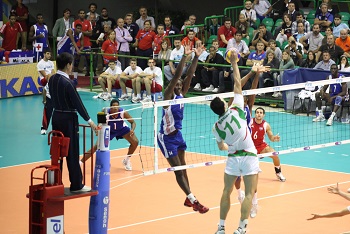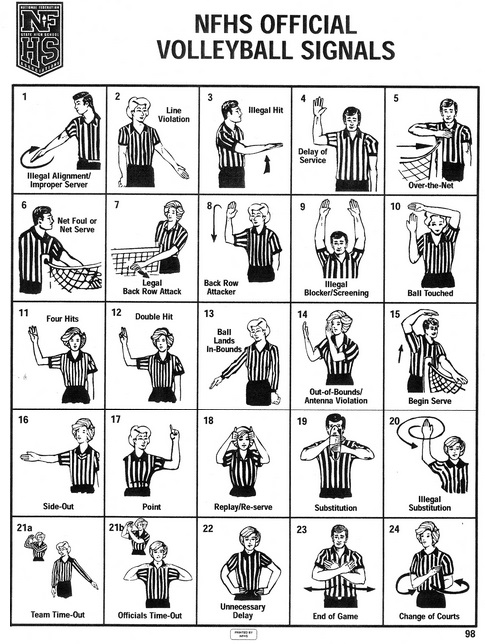New High School Rules and Recent Rule Changes
Know your high school volleyball rules. Being up to date on current rules is important for everyone involved in volleyball.
Coaches need to know the rules because there are advantages and disadvantages to knowing what you can and can’t do.
Players need to understand the rules and how volleyball can be played in each situation.
All players, coaches, and fans knowing the high school volleyball rules will help everyone be less stressed because they will better understand a call made by the referees.

Rule 1-3-3
A loss of rally/point is awarded each time a vacant position rotates to serve in the right back position.
This new rule outlines the procedure for scoring when a vacant position rotates to serve in the right back position due to the team playing with fewer than six players as a result of illness, injury or disqualification.
Rationale: Provides clarification of proper scoring protocol when a team plays with fewer than 6 players due to injury, illness, or disqualification, after the start of the match.
Rule 2-1-9 and 2-1-10
The playable area includes the court and the unobstructed space outside the f the court boundary lines,. The playable area outside of the court boundary lines shall be visible to all team member and officials.
Nonplayable area is that space located beyond the court and surrounding playable area. It includes walls, bleachers, team benches, area behind the team benches, and any other areas identified in the pre-match conference, deemed by the first referee as unsuitable for playable area.
This new rule adds the definitions for playable and nonplayable areas and stipulates the first referee has the authority to identify other area (s) as unsuitable for play.
Rationale: The high school volleyball rules currently refer to playable and nonplayable areas. For clarification, these areas are now defined. The first referee has the authority to identify other unsuitable areas for play.

Hand Signals for High School Volleyball Rules
3-1-1
The net shall be 36 inches to 39 inches wide overall and at least 31’6″ up to 33 feet in length when stretched. A plain white 2-inch to 2 and 3/4 inch wide double thickness of canvas or single thickness of durable synthetic material shall be sewn along the full length of the top of the net. A white sleeve no wider than 3 and 3/8 inches may be installed along the top of the net.
The overall width and length of the net may now fall within a range with the width of the net overall being 36 inches to 39 inches and the length being 31 feet 6 inches to 33 feet.
Rationale: The inclusion of a range makes legal the various equipment being utilized by high school teams should matches be conducted in college facilities. The change does not require new equipment and eliminates need for manufacturers to make different nets which many schools are not correctly purchasing.
The plain white tape along the top of the net shall be 2 inches up to 2 ¾ inches wide. A white net sleeve, no wider than 3 3/8 inches, with the school name, insignia, school mascot and/or advertising may be installed along the top of the net. Rationale: The inclusion of the range makes legal the various equipment being utilized by high schools should matches be conducted in college facilities. The use of a manufactured sleeve allows the school to place their name, mascot, insignia and/or advertising on the net without expense of a custom net to promote school spirit and opportunity as a source for additional revenue.
Rule 4-1-5
Hair devices made of soft material and no more than 2 inches wide may be worn. Booby pins, flat clips and flat barrettes, unadorned and no longer than 2 inches, are also allowed.
This new rule added to the high school volleyball rules expands the style of items that may be worn in the hair to include unadorned flat barrettes no longer than 2 inches.
Rationale: Flat, unadorned barrettes, no longer than two inches, do not create a concern for risk of injury and can be securely fastened and serve as efficient means to control a players hair.
Rule 5-1-3
The referees maintain administrative responsibilities for the contest through the completion of any required reports or correspondence in response to any action occurring while the referees have jurisdiction. State associates may intercede n the event of unusual incidence after referees’ jurisdiction has ended or in the event that a contest is terminated prior to the conclusion of regulation play.
Rule 5-2-1
The individual state association may make a temporary adjustment in the officials uniform and permit the wearing of a white shirt or sweater to address cold conditions within competition facilities.
Rationale: This rule is added to the high school volleyball rules because many times officials will be required to work in gymnasiums in which the temperature is quite cool. Rather than each official wearing different visible undergarments or different style shirts, the state association may develop a policy to permit a standard style long-sleeved shirt or sweater and still maintain the integrity of the officials uniform.
If you enjoyed these tips and would like to keep it close to you at any time, just save this pin to your Pinterest Volleyball Board.

Home › Basic Rules › High School
